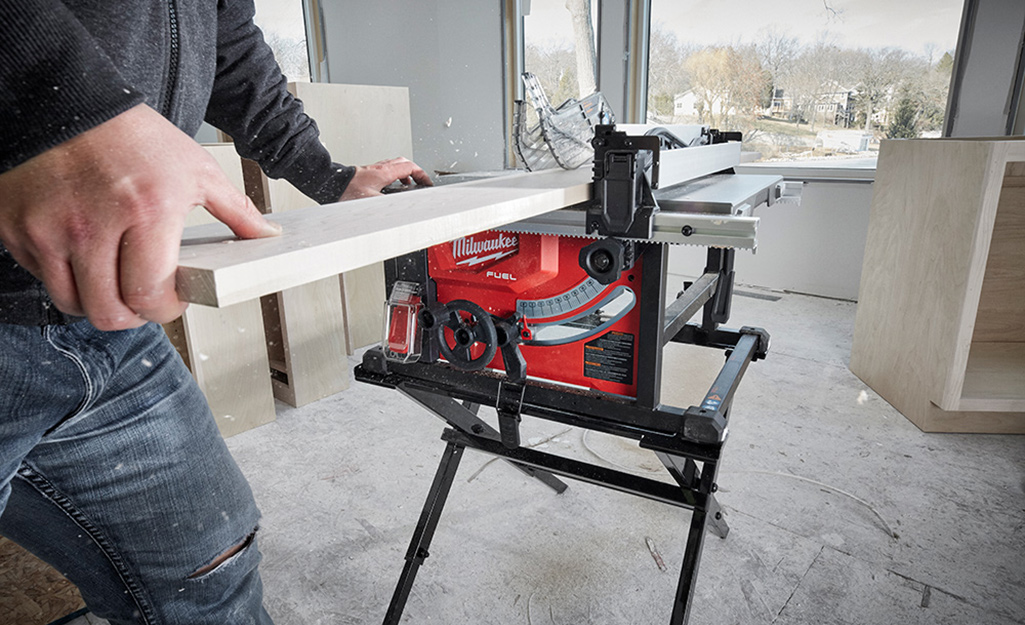A table saw is a tool that uses a spinning blade to cut wood. Yes, a table saw can be dangerous if not used properly, so learning table saw safety is key. In this guide, we’ll explore how to use table saw safely and accurately, perfect for using a table saw for beginners. We’ll cover everything from basic table saw techniques to choosing the right table saw blade, performing table saw ripping and crosscutting with table saw, and even some simple table saw projects. This guide will also discuss table saw jigs, and table saw maintenance.

Image Source: contentgrid.homedepot-static.com
Why a Table Saw is a Workshop Essential
The table saw is the heart of many woodworking shops. It’s versatile and can make accurate, repeatable cuts. Whether you’re building furniture, cabinets, or small crafts, a table saw will make your work easier and faster. It can perform a variety of cuts, including ripping (cutting along the grain), crosscutting (cutting against the grain), and even angled cuts. With the right accessories, a table saw can also be used for making dadoes and rabbets.
What Makes a Table Saw So Useful?
- Precision: Allows for highly accurate cuts.
- Repeatability: Can easily make multiple cuts of the same size.
- Versatility: Suitable for a wide range of woodworking tasks.
- Efficiency: Cuts material much faster than many hand tools.
Getting Started: The Anatomy of a Table Saw
Before diving into cutting wood with table saw, let’s familiarize ourselves with the different parts of a table saw. This knowledge is essential for safe and effective operation.
- Table: The flat surface where the wood rests.
- Blade: The circular cutting tool that protrudes through the table.
- Arbor: The shaft that holds the blade.
- Motor: Provides the power to spin the blade.
- Fence: A guide that runs parallel to the blade for ripping.
- Miter Gauge: A guide that slides in a slot for crosscutting.
- Blade Guard: A safety device to protect your hands from the blade.
- Riving Knife/Splitter: Prevents the wood from pinching the blade.
- Anti-Kickback Pawls: Prevents the wood from being thrown back at you.
- Handwheels: Used to adjust the blade height and angle.
- Dust Port: Connects to a dust collection system.
Table Saw Safety: Protecting Yourself
Table saw safety is paramount. A table saw can cause serious injury if not used properly. Always follow these safety rules:
Essential Safety Rules
- Read the Manual: Familiarize yourself with your saw’s specific instructions.
- Wear Safety Glasses: Protect your eyes from flying debris.
- Use Hearing Protection: Table saws are loud.
- Wear a Dust Mask: Protect your lungs from sawdust.
- Never Reach Over the Blade: Turn off the saw if you need to reach something.
- Keep Hands Away from the Blade: Use push sticks or push blocks to guide the wood.
- Don’t Wear Loose Clothing: Loose clothing can get caught in the blade.
- Remove Jewelry: Jewelry can also get caught in the blade.
- Never Force the Wood: Let the blade do the cutting.
- Use the Riving Knife/Splitter: Prevents kickback.
- Use the Blade Guard: Provides a physical barrier between your hands and the blade.
- Unplug the Saw Before Maintenance: Prevents accidental starts.
- Stay Focused: Avoid distractions when using the saw.
- Know Your Wood: Be aware of knots or imperfections that can cause issues.
- Use Featherboards: Featherboards help keep the wood tight against the fence or table.
What is Kickback?
Kickback is when the wood is caught by the rising teeth of the blade and thrown back towards the operator. This can happen if the wood pinches the blade or if the wood is not properly supported. To prevent kickback, always use the riving knife/splitter and anti-kickback pawls. Also, never stand directly behind the wood while cutting.
Choosing the Right Table Saw Blade
The table saw blade you use has a big impact on the quality of your cuts. Different blades are designed for different purposes.
Types of Blades
| Blade Type | Use | Teeth Count | Description |
|---|---|---|---|
| Combination Blade | General purpose cutting, both ripping and crosscutting | 40-50 | A good all-around blade for most tasks. |
| Ripping Blade | Cutting along the grain of the wood (ripping) | 24-30 | Designed for fast, efficient cutting along the grain. |
| Crosscut Blade | Cutting across the grain of the wood (crosscutting) | 60-80 | Produces clean, smooth cuts across the grain. |
| Dado Blade Set | Cutting wide grooves (dadoes) or rabbets | Varies | A set of blades and chippers that can be stacked to create different widths of cuts. |
| Plywood Blade | Cutting plywood and other sheet goods | 80+ | Has a high tooth count and a special grind to minimize splintering. |
| Non-Ferrous Metal Blade | Cutting aluminum, brass, and other non-ferrous metals | Varies | Specially designed for cutting metals, with a negative hook angle to prevent the blade from grabbing. |
How to Change a Table Saw Blade
- Unplug the Saw: Safety first!
- Raise the Blade: Raise the blade as high as it will go.
- Lock the Arbor: Most saws have a spindle lock.
- Loosen the Arbor Nut: Use the correct wrench to loosen the nut. Note that some saws have a left-handed thread.
- Remove the Blade: Carefully remove the old blade.
- Install the New Blade: Make sure the blade is facing the correct direction (check the arrows on the blade).
- Tighten the Arbor Nut: Tighten the nut securely.
- Release the Arbor Lock: Release the spindle lock.
- Lower the Blade: Lower the blade to the desired height.
Basic Table Saw Techniques: Ripping and Crosscutting
The two most common table saw techniques are ripping and crosscutting. Ripping is cutting along the grain of the wood, while crosscutting is cutting across the grain.
Table Saw Ripping
Table saw ripping is cutting a board along its length, parallel to the grain.
- Set the Fence: Adjust the fence to the desired width.
- Place the Wood: Place the wood against the fence and the table.
- Turn on the Saw: Let the blade reach full speed before cutting.
- Feed the Wood: Slowly and steadily feed the wood into the blade, keeping it tight against the fence.
- Use Push Sticks: Use push sticks or push blocks to guide the wood through the last part of the cut, keeping your hands away from the blade.
- Complete the Cut: Continue pushing the wood until it has completely passed the blade.
- Turn Off the Saw: Wait for the blade to stop spinning before removing the wood.
Crosscutting with Table Saw
Crosscutting with table saw is cutting a board across its width, perpendicular to the grain.
- Use the Miter Gauge: Insert the miter gauge into one of the slots on the table.
- Set the Angle: Adjust the angle of the miter gauge if necessary.
- Place the Wood: Place the wood against the miter gauge.
- Turn on the Saw: Let the blade reach full speed before cutting.
- Feed the Wood: Slowly and steadily push the miter gauge and the wood through the blade.
- Complete the Cut: Continue pushing until the wood has completely passed the blade.
- Turn Off the Saw: Wait for the blade to stop spinning before removing the wood.
Miter Saw vs. Table Saw for Crosscutting
While both miter saws and table saws can be used for crosscutting, they have different strengths. Miter saws are generally better for making angled cuts and repetitive cuts of the same length. Table saws are better for cutting large pieces of wood and for making very precise cuts.
Essential Table Saw Jigs
Table saw jigs are accessories that help you make more accurate and safer cuts.
Types of Jigs
- Push Stick: Used to safely guide wood past the blade.
- Push Block: Similar to a push stick, but wider for more stability.
- Miter Saw Sled: A platform that slides in the miter slot, providing better support for crosscutting.
- Tenoning Jig: Used to cut tenons for mortise-and-tenon joints.
- Dado Jig: Used to cut dadoes and rabbets.
- Featherboard: Holds the wood tight against the fence or table, preventing it from moving during the cut.
How to Make a Simple Miter Saw Sled
A miter saw sled is a great addition to any table saw. Here’s how to make one:
- Cut the Base: Cut a piece of plywood or MDF to the desired size.
- Attach the Runners: Cut two pieces of wood that fit snugly into the miter slots on your table saw. Glue and screw these pieces to the bottom of the base.
- Add the Fence: Cut a piece of wood and attach it to the base, perpendicular to the runners. This will be your fence.
- Add a Zero-Clearance Insert: Cut a piece of wood and attach it to the base, flush with the blade. This will provide support for the wood as it is being cut, reducing splintering.
Table Saw Maintenance: Keeping Your Saw in Top Condition
Regular table saw maintenance is essential for keeping your saw running smoothly and safely.
Maintenance Tasks
- Clean the Saw: Remove sawdust and debris from the table, blade, and motor.
- Lubricate Moving Parts: Use a dry lubricant on the fence, miter gauge, and blade height adjustment mechanism.
- Check the Blade Alignment: Make sure the blade is parallel to the miter slot.
- Check the Fence Alignment: Make sure the fence is parallel to the blade.
- Sharpen or Replace the Blade: A dull blade can be dangerous and produce poor quality cuts.
- Inspect the Power Cord: Check for damage and replace if necessary.
Table Saw Troubleshooting
| Problem | Possible Cause | Solution |
|---|---|---|
| Saw won’t start | Power cord not plugged in, tripped breaker | Check power cord, reset breaker |
| Blade vibrates | Blade not properly installed, arbor nut loose | Reinstall blade, tighten arbor nut |
| Cuts are not straight | Fence or blade not aligned | Align fence and blade |
| Wood burns during cutting | Dull blade, feeding too slowly | Sharpen or replace blade, increase feed rate |
| Kickback | Wood pinching blade, not using riving knife | Use riving knife, avoid pinching the blade |
| Excessive sawdust | Dust collection system not working properly | Check dust collection system, ensure proper airflow |
| Motor overheating | Sawdust buildup, dull blade | Clean saw, sharpen or replace blade |
Simple Table Saw Projects for Beginners
Now that you know the basics, here are a few simple table saw projects to get you started:
Cutting Board
A cutting board is a great way to practice your ripping and crosscutting skills.
- Choose Your Wood: Select a hardwood such as maple, walnut, or cherry.
- Cut the Strips: Rip the wood into strips of varying widths.
- Glue the Strips: Glue the strips together, alternating the grain direction for strength.
- Clamp the Board: Clamp the board until the glue is dry.
- Plane the Board: Plane the board flat.
- Cut to Size: Crosscut the board to the desired size.
- Round the Edges: Round the edges with a router or sandpaper.
- Finish the Board: Apply a food-safe finish.
Bookends
Bookends are another easy project that requires only a few cuts.
- Choose Your Wood: Select a hardwood such as oak or maple.
- Cut the Pieces: Cut the wood into the desired shapes.
- Sand the Pieces: Sand the pieces smooth.
- Assemble the Bookends: Glue and screw the pieces together.
- Finish the Bookends: Apply a finish of your choice.
Fathoming Advanced Table Saw Techniques
Once you’re comfortable with the basics, you can start to explore more advanced table saw techniques.
Cutting Dadoes and Rabbets
Dadoes are grooves cut into the wood, while rabbets are grooves cut along the edge of the wood. These cuts are often used for joining pieces of wood together.
- Use a Dado Blade Set: Install a dado blade set in your table saw.
- Set the Width and Depth: Adjust the width and depth of the cut.
- Make the Cut: Slowly and steadily feed the wood into the blade.
Cutting Tenons
Tenons are projections that fit into mortises (holes) to create strong joints.
- Use a Tenoning Jig: A tenoning jig will help you make accurate and repeatable cuts.
- Set the Blade Height: Adjust the blade height to the desired tenon thickness.
- Make the Cuts: Slowly and steadily feed the wood into the blade, rotating the wood after each cut.
Frequently Asked Questions (FAQ)
- Can I cut metal with a table saw?
- Yes, but only with a blade specifically designed for cutting metal. Use caution and wear appropriate safety gear.
- What is the best way to prevent kickback?
- Always use the riving knife/splitter, anti-kickback pawls, and feed the wood steadily. Never stand directly behind the wood while cutting.
- How often should I sharpen my table saw blade?
- It depends on how often you use the saw and what type of wood you are cutting. A good rule of thumb is to sharpen the blade when it starts to produce rough cuts or requires more force to push the wood through.
- How do I choose the right table saw for my needs?
- Consider the size of your projects, the amount of space you have, and your budget. Portable table saws are good for small projects and limited space, while cabinet saws are better for larger projects and provide more power and accuracy.
- Is it safe to use a table saw without a blade guard?
- No, it is not recommended. The blade guard is an important safety device that helps protect your hands from the blade.
- Who is liable if I get injured while using a table saw at work?
- Liability depends on the specifics of the incident, but generally, employers are responsible for providing a safe work environment and properly maintained equipment. Workers’ compensation insurance may also cover injuries.
By following these table saw safety guidelines and practicing these table saw techniques, you can safely and effectively use a table saw for a wide range of woodworking table saw projects. Remember to always prioritize safety and take your time to learn the proper techniques. Happy woodworking!

Hi, I’m Tom Scalisi, and welcome to The Saw Blog! I started this blog to share my hands-on experience and insights about woodworking tools—especially saws and saw blades. Over the years, I’ve had the chance to work with a wide range of tools, and I’m here to help both professionals and hobbyists make informed decisions when it comes to selecting and using their equipment. Whether you’re looking for in-depth reviews, tips, or just advice on how to get the best performance out of your tools, you’ll find it here. I’m excited to be part of your woodworking journey!
